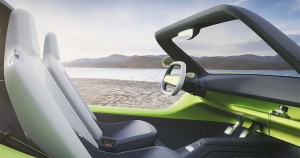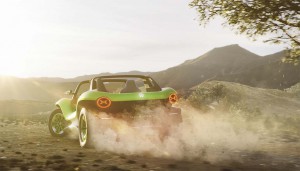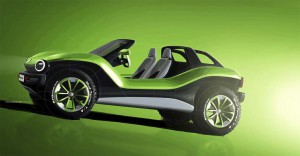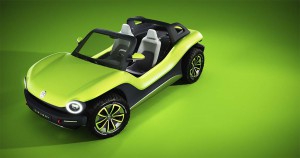Where are the Beach Boys when you need them? That classic California surf rock band would seem to be able to provide the perfect soundtrack for the latest all-electric show car from Volkswagen, the I.D. Buggy.
Drawing inspiration from the once popular sand-crawlers of the 1960s and 1970s, this retro-futuristic concept vehicle gives another look at the flexibility of VW’s new, battery-electric MEB architecture, a platform that will used for the majority of the more than 50 all-electric vehicles the German automaker plans to launch by 2025.
The original Beetle was the starting point for most of those dune buggies, raising the question of whether the I.D. Buggy might hint at the revival of the Bug in all-electric form.
VW offered a sneak peek at the I.D. show car in January, but it has now pulled off the camouflage. And what we find is a very high-tech take on the classic dune buggy formula. That starts with the modular MEB platform that here houses a 62 kilowatt-hour lithium battery under its load floor. That powers a single, 201-horsepower electric motor driving the rear wheels.
(VW plugs in with new dune buggy concept. Click Here for the story.)
According to VW, it should deliver a range of around 155 miles using the European WLTP test cycle. On pavement, the Buggy is rated at a 99 mph top speed and can hit 100 km, or 62 mph, in just 7.2 seconds.
Like the dune buggies of the past, the minimalist two-seat design has no roof and no doors, just a chopped windshield to keep the sand and salt spray out of your eyes.
The flexibility of the MEB architecture, VW notes, allows the I.D. Buggy to be converted to a 2+2 seater, while an additional motor could be mounted onto the front axle to both boost performance and give the sand crawler all-wheel drive.
The I.D. Buggy’s dimensions are similar to those of classic dune buggies, measuring 160.0 in long, 74.4 in wide and 57.6 in high. The wheelbase is 104.3 in and ground clearance is 9.4 in.
Visually, the design picks up on those early, Beetle-based buggies, with prominently flaired fenders and hood, though the use of a battery drive system, rather than a Beetle four-cylinder air-cooled engine, means there’s no need for a grille. Add some more modern elements, including oval LED head and taillamps, as well as an LED VW logo. A reinforced targa bar provides rollover protection.
The Buggy rides on off-road, 18-inch BFGoodrich tires. Meanwhile, there’s a solid aluminum underbody guard to protect the concept vehicle’s battery and suspension system.
(Click Here to see more about VW’s $800 million EV plant coming to Chattanooga.)
By mounting the motors and batteries under the load floor, VW has been able to stretch out the interior of the I.D. Buggy. The cabin is as minimalist as a classic dune buggy, with waterproof materials designed to stand up to the elements. There’s a digital instrument cluster behind the hexagonal steering wheel and touch-operated controls mounted into the crossbar.

The interior of the I.D. Buggy is clean and simple, much like the vehicles designers were inspired by.
Borrowing a page from the original Meyers Manx, the grandfather of all dune buggies, the I.D. Buggy is designed to give third-party converters the opportunity to get creative.
The German automaker isn’t talking about plans for the show car, but it’s helpful to note that most of the I.D. concept vehicles it has shown off in recent years have been translated into production models.
The third-generation Beetle will fade to black at the end of the 2019 model-year, a victim of declining demand. When plans were announced for the Beetle’s “Final Edition” last August, Hinrich Woebcken, then the head of the Volkswagen Group of America said “there are no immediate plans to replace it,” but he added that “I would also say, ‘Never say never.’”
VW insiders have hinted at a possible revival of the once-beloved Beetle and the upcoming debut of the Volkswagen Dune Buggy concept could be a signal that something really is in the works.
(Hippies rejoice: the Microbus is coming back – and this time it will be electric. Click Here for more.)
As for producing an actual dune buggy? VW never produced one of its own, but the automaker estimates that worldwide as many as 250,000 Beetles were modified into dune buggies or other unique models by the 1980s.



